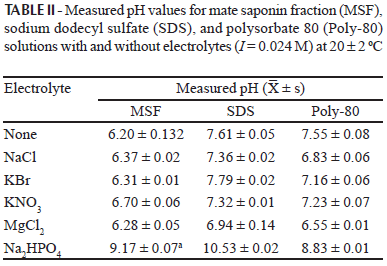Saponins are natural compounds able to form abundant foam, a desirable quality required in some chemical, foods, cosmetic and pharmaceutical processes. Ilex paraguariensis A. St. Hil. (Aquifoliaceae) known as mate, is a South American widely cultivated specie due to the preparation of a tea-like beverage from its leaves. Moreover, its green fruits are a rich source of non-toxic and very low haemolytic saponins. In this study, mate saponin fraction (MSF) was evaluated as a foam former, focusing on its foamability, foam lifetime, and film drainage in the presence of different electrolytes (ionic strength I = 0.024 M). Sodium dodecyl sulphate (SDS) and polysorbate 80 (Poly-80) were used as reference surfactants. The critical micelle concentration (CMC), the minimum attainable surface tension (γCMC), surface excess concentration (Γ) and cross-section molecular surface (A) values of MSF were comparable to those of Poly-80. The foamability of MSF and both reference surfactants was equivalent. The addition of MgCl2 resulted in a negative effect on MSF foamability. The salts NaCl, KBr, and KNO3 exhibited a negative influence on MSF foam lifetime. Similar behavior was observed for MSF film drainage (order of activity: Na2HPO4 > MgCl2 ≈ NaCl ≈ KNO3 > KBr), where a primary fast film drainage rate was followed by film thinning stabilization after around 5 min. The behavior described above seems to be uncorrelated to the solutions' zeta potential.
Ilex paraguariensis; Aquifoliaceae; Mate; saponins; Surfactants; foam; assay








